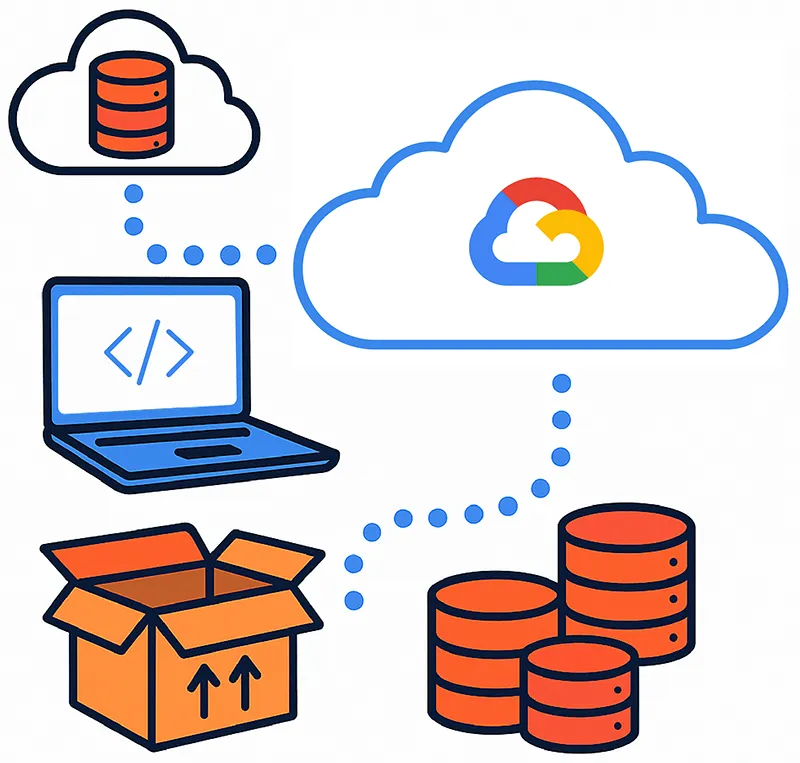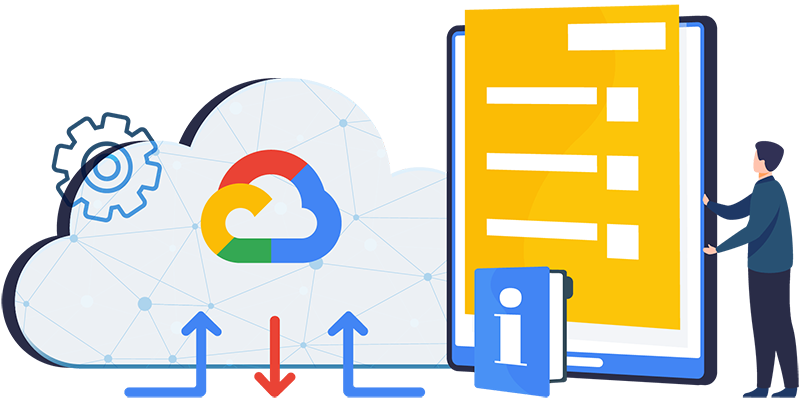Table of contents
- Why сloud migration matters for businesses in 2025
- Live migration to Google Cloud: From any source environment
- Why companies choose Google Cloud Platform
- Common challenges when moving to Google Cloud
- Key considerations before migrating
- Business benefits of migrating to Google Cloud
- How to migrate to Google Cloud Platform with Hystax Acura

Why сloud migration matters for businesses in 2025
In 2025, cloud migration has become more than a modernization trend — it’s a survival strategy. Companies seek agility, scalability, and cost transparency as digital transformation deepens. According to industry reports, about 87% of enterprises now operate in a hybrid or multi-cloud environment, and over 50% of all data will reside in the cloud by 2026, as organizations continue shifting storage and processing away from on-premises systems.
Google Cloud Platform (GCP) stands out with its AI-driven services, global network, and sustainable infrastructure, making it a top choice for enterprises planning large-scale digital shifts. Google Cloud continues to strengthen its position in this landscape. In Q2 2025, it held approximately 13% of the global cloud infrastructure market, growing faster than most competitors and generating over $13 billion in quarterly revenue. This growth reflects rising confidence among enterprises choosing GCP as a foundation for modernization.

Live migration to Google Cloud: From any source environment
As we have already mentioned above, modern companies often operate across multiple clouds and data centers. When they decide to migrate to Google Cloud, the primary challenge is typically ensuring a seamless transition with minimal downtime or business disruption, and data loss. That’s where Google Cloud live migration becomes essential. It allows workloads to move directly from any public or private cloud — or even on-premises infrastructure — to the mentioned public cloud while maintaining full operational functionality.
Several global enterprises have already completed large-scale moves to GCP, proving how reliable and scalable the platform is:
- PayPal migrated its analytics and data-processing systems to Google BigQuery, enabling faster insights and reducing infrastructure overhead.
- Evernote successfully transferred over 5 billion notes and attachments into Google’s cloud environment in just a few weeks, maintaining continuous access for millions of users during the process.
- Box, the collaboration and content-management platform, shifted critical workloads to GCP to gain stronger network visibility and improve application performance across its global user base.
These examples demonstrate how Google Cloud live migration empowers organizations to modernize their infrastructure, enhance reliability, and access advanced services such as data analytics, machine learning, and automation — all without interrupting operations.
Why companies choose Google Cloud Platform
The reasons for Google Cloud migration go far beyond cost optimization. Enterprises see GCP as a long-term foundation for digital transformation — one that combines performance, flexibility, and innovation. Here are some of the key factors driving adoption:
AI and ML innovation
Google Cloud is at the forefront of artificial intelligence and machine learning. Tools like Vertex AI, TensorFlow, and AutoML enable companies to build, train, and deploy advanced models directly within their cloud environment. For organizations working with data-driven products — from retail analytics to healthcare — this native AI integration helps accelerate decision-making and product development cycles.
Data and database performance
GCP offers high-performing and scalable data services, including Google Cloud SQL, BigQuery, and Firestore, which simplify data management across global operations. With built-in tools like Google Cloud Database Migration Service, enterprises can modernize legacy databases while minimizing downtime. This unified approach to data, from storage to analytics, makes GCP particularly attractive for businesses seeking to centralize and automate their data operations.
Security and compliance
Every Google Cloud migration comes with Google’s enterprise-grade security framework. Data encryption at rest and in transit, multi-layered IAM policies, and a robust zero-trust architecture help safeguard sensitive workloads. Combined with compliance across major standards (ISO 27001, SOC 2, GDPR, HIPAA, and more), GCP ensures that even regulated industries like finance and healthcare can operate confidently in the cloud.
Sustainability and carbon neutrality
Google Cloud runs on 100% renewable energy and is one of the few providers committed to operating entirely carbon-free by 2030. For businesses striving to meet ESG targets or achieve sustainability certifications, GCP becomes a strategic partner that aligns with long-term environmental goals — without compromising performance.
Global scale and reliability
With data centers in over 35 regions, GCP ensures low latency, high availability, and redundancy worldwide. Enterprises migrating workloads to GCP gain the advantage of a distributed infrastructure that can withstand regional outages, handle traffic spikes, and support global customer bases with ease.

Common challenges when moving to Google Cloud
Migrating workloads and data to Google Cloud Platform offers significant benefits — but also presents a few technical and organizational hurdles. Understanding them early helps teams plan effectively and minimize disruption.
Downtime risks during transition
One of the primary concerns during cloud migration is the potential for service interruptions. Even brief downtime can affect critical operations or user experience. Careful scheduling, background replication, and pre-cutover testing are key to keeping systems available throughout the process.
Compatibility and dependency issues
Legacy applications often depend on outdated operating systems, custom middleware, or closely tied databases that aren’t fully compatible with modern GCP services. Before initiating a large-scale data transfer, it’s crucial to analyze all dependencies between applications, databases, and storage layers to prevent potential performance degradation after the switch.
Data integrity and synchronization
Maintaining data consistency between the source and target environments is another significant challenge. Incomplete transfers or mismatched schemas can lead to corrupted records or lost transactions. Incremental replication and validation checks during the process help ensure that all information remains accurate and reliable in the new environment.
Security and compliance alignment
Moving workloads to the cloud means adapting security frameworks and meeting compliance requirements. Teams must configure identity management, encryption, and audit policies in accordance with GCP’s shared responsibility model. A well-designed migration plan helps maintain data protection and ensures compliance with standards such as GDPR, SOC 2, and HIPAA.
Skill and knowledge gaps
GCP introduces its own architecture, networking model, and cost management tools. Without proper training, teams can face configuration errors or inefficient resource allocation. Leveraging official resources such as the Google Cloud Data Migration Center or certified partners can help bridge the expertise gap and streamline the transition.
By addressing these challenges in advance, organizations can achieve a smoother, faster, and more predictable move to GCP — with stronger performance, security, and reliability from day one.
Let us show you how Hystax Acura can automate and simplify your exact migration scenario just in a couple of clicks.
Thank you for your request!
We will be in touch soon.
We respect your privacy. See our Privacy Policy. You can unsubscribe at any time.
Key considerations before migrating
A successful Google Cloud Platform migration begins with thorough planning and preparation. By evaluating technical, operational, and security aspects in advance, organizations can prevent most of the issues that typically arise during migration.
1. Source infrastructure
Start by analyzing where your workloads currently run — whether on VMware, Hyper-V, KVM, OpenStack, or bare metal servers. Understanding the current configuration helps identify dependencies and compatibility gaps before moving to a new environment. This stage also involves mapping workloads, assessing performance needs, and determining which applications are ready for migration versus those that may need refactoring.
2. Target architecture
Designing the correct target architecture in GCP is essential to achieving long-term scalability and cost efficiency. You’ll need to define compute types, storage classes, and networking configurations that match your workload requirements. Planning these elements ahead of time prevents over-provisioning and ensures that the new infrastructure fully supports your business continuity and performance goals.
3. Connectivity and access
Secure, stable connectivity between your source environment and Google Cloud is a prerequisite for a seamless migration. Options like VPN, Cloud Interconnect, or private peering ensure low-latency data transfer and encrypted communication. It’s also vital to review firewall settings, access policies, and bandwidth limitations to avoid interruptions during replication or testing.
4. Testing environment
Before switching production workloads, set up a controlled testing environment in GCP. Here, you can perform test migrations, validate application behavior, and ensure that all configurations work as expected. Thorough testing reduces the risk of errors, improves cutover accuracy, and gives teams confidence that their applications will perform correctly after going live.
5. Security and compliance requirements
Every migration must align with your organization’s security policies and regulatory obligations. Define encryption standards, backup policies, and IAM roles early in the process. Adhering to compliance frameworks such as GDPR, ISO 27001, or HIPAA ensures that sensitive data remains protected both in transit and at rest.
Taking these factors into account creates a strong foundation for a reliable, secure, and efficient transition to Google Cloud — minimizing risks and helping teams move with confidence.

Business benefits of migrating to Google Cloud
Migrating workloads and applications to Google Cloud unlocks new levels of agility, efficiency, and innovation. Beyond the technical upgrade, it’s a strategic move that enables companies to operate smarter, scale faster, and build more resilient IT ecosystems.
1. Optimized costs and flexible pricing
Google Cloud’s pay-as-you-go model helps companies align IT spending with actual usage, reducing waste caused by idle resources. Features such as committed use discounts and sustained use savings allow predictable budgeting and long-term cost efficiency. Additionally, tools for resource monitoring and cost analysis facilitate the tracking of expenses and identification of optimization opportunities.
2. Scalability on demand
With Google Cloud’s global infrastructure, organizations can instantly scale computing power, storage, or networking resources as workloads grow. This flexibility is especially valuable for businesses that experience seasonal spikes or unpredictable demand. Auto-scaling and load balancing ensure that performance remains stable without manual intervention.
3. Enhanced reliability and uptime
GCP is built on one of the most resilient cloud networks in the world, with multi-region redundancy and self-healing infrastructure. Companies benefit from high availability, automatic failover, and near-zero downtime even during maintenance events. This reliability is crucial for mission-critical services that can’t afford interruptions.
4. Advanced analytics and AI capabilities
One of Google Cloud’s biggest differentiators is its integration with powerful AI and machine learning tools. Businesses can use services like Vertex AI, BigQuery, and Cloud Dataflow to process data in real time, generate insights, and automate decision-making. These capabilities transform raw information into strategic value, helping companies stay ahead in data-driven industries.
5. Strong security and compliance posture
Google Cloud offers a layered approach to security, featuring default encryption, secure identity management, and a zero-trust framework. Compliance with international standards, such as ISO, SOC, and GDPR, ensures that enterprises in regulated industries can safely migrate sensitive workloads without compromising security. Continuous monitoring and threat detection systems help maintain a robust security baseline across all environments.
6. Support for innovation and sustainability
Operating on Google Cloud means access to an ever-expanding portfolio of developer tools, APIs, and open-source integrations. This accelerates innovation cycles and simplifies the deployment of modern, cloud-native applications. Moreover, GCP’s carbon-neutral data centers allow organizations to meet environmental and ESG goals while maintaining top performance.
Migrating to Google Cloud isn’t just about infrastructure change — it’s about enabling a more adaptive, intelligent, and future-ready business.
Our team will help you assess all migration risks, identify critical workloads, and build a step-by-step execution plan, including testing and rollback scenarios.
Thank you for your request!
We will be in touch soon.
We respect your privacy. See our Privacy Policy. You can unsubscribe at any time.

How to migrate to Google Cloud Platform with Hystax Acura
Hystax Acura fully automates the entire Google Cloud migration process, enabling companies to quickly and securely move workloads from any source platform — public, private, or on-premises — to GCP. The process consists of five straightforward stages:
Step 1: Start replication
Begin continuous background replication of your business applications, machine data, and metadata — all without performance impact or downtime. Hystax Acura ensures that every workload remains fully operational throughout the process.
Step 2: Store data on the target cloud
During replication, all data is securely stored on the target site using volumes and snapshots, guaranteeing complete data consistency and recovery points at every stage.
Step 3: Automate orchestration
Hystax Acura’s automated orchestration engine launches fully functional business applications in GCP. This automation eliminates manual configuration steps, ensuring that all components start in the correct order.
Step 4: Spin up test migrations
Run an unlimited number of test migrations in an isolated GCP VPC. This allows teams to execute functional and performance validations without impacting production systems, ensuring a seamless final cutover.
Step 5: Run final cutover
Perform the final migration — or live cutover — within a small and predictable maintenance window. Applications are automatically switched to run in Google Cloud with no data loss and minimal downtime.
Get more information about the Hystax Acura installation guide for GCP here.
With the right automation tools and the reliability of Google Cloud Platform, organizations can execute a secure and efficient migration process, achieving consistent results and uninterrupted business continuity. Fully automated solutions like Hystax Acura make this process faster, transparent, and fully controlled from start to finish.

